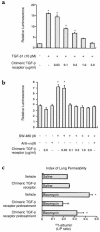TGF-beta is a critical mediator of acute lung injury
- PMID: 11413161
- PMCID: PMC200192
- DOI: 10.1172/JCI11963
TGF-beta is a critical mediator of acute lung injury
Abstract
We have shown that the integrin alphavbeta6 activates latent TGF-beta in the lungs and skin. We show here that mice lacking this integrin are completely protected from pulmonary edema in a model of bleomycin-induced acute lung injury (ALI). Pharmacologic inhibition of TGF-beta also protected wild-type mice from pulmonary edema induced by bleomycin or Escherichia coli endotoxin. TGF-beta directly increased alveolar epithelial permeability in vitro by a mechanism that involved depletion of intracellular glutathione. These data suggest that integrin-mediated local activation of TGF-beta is critical to the development of pulmonary edema in ALI and that blocking TGF-beta or its activation could be effective treatments for this currently untreatable disorder.
Figures






References
-
- Ware LB, Matthay MA. The acute respiratory distress syndrome. N Engl J Med. 2000;342:1334–1349. - PubMed
-
- Hakkinen PJ, et al. Potentiating effects of oxygen in lungs damaged by methylcyclopentadienyl manganese tricarbonyl, cadmium chloride, oleic acid, and antitumor drugs. Toxicol Appl Pharmacol. 1983;67:55–69. - PubMed
-
- Van Barneveld PW, et al. Natural course of bleomycin-induced pneumonitis. A follow-up study. Am Rev Respir Dis. 1987;135:48–51. - PubMed
Publication types
MeSH terms
Substances
Grants and funding
LinkOut - more resources
Full Text Sources
Other Literature Sources
Molecular Biology Databases

